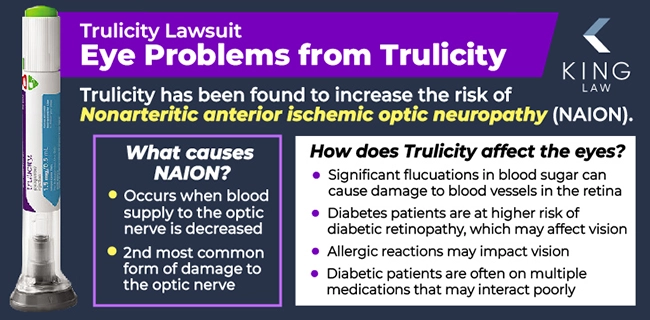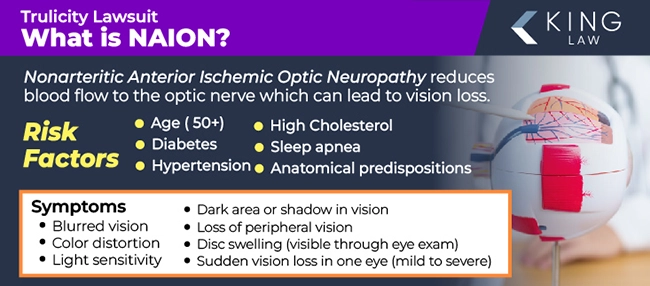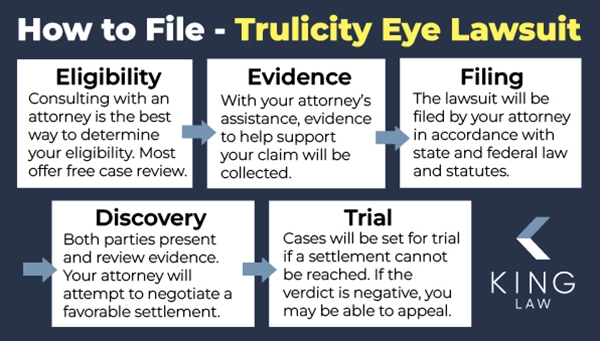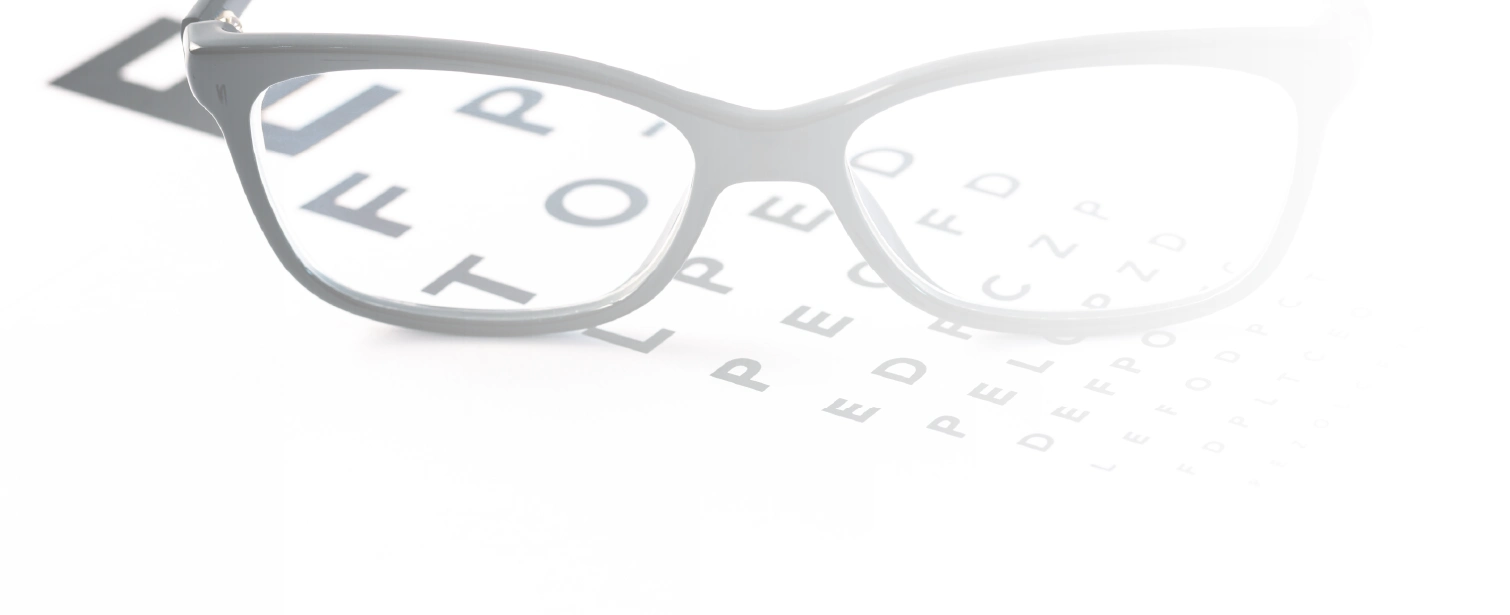
Individuals are filing lawsuits against the manufacturer of Trulicity (dulaglutide), Eli Lilly and Company, alleging that the medication may increase a person’s risk for developing serious side effects such as vision loss, blurry vision, and blindness. Common eye injuries associated with type 2 diabetes and obese/overweight patients taking GLP-1 receptor agonists, such as Trulicity, include Nonarteritic Anterior Ischemic Optic Neuropathy (NAION), dry eye syndrome, and eye twitching.
Litigation is ongoing, with more expected to be filed over the next months. Affected individuals are encouraged to contact an experienced attorney to determine if they are eligible for compensation.
Trulicity Eye Side Effects Lawsuit Overview
Current lawsuits against Eli Lilly, the manufacturer of Trulicity, allege that the company knew of the risks associated with using the medication and failed to warn users about the dangers. Risks associated with the drug include the potential for an increased risk of developing NAION. NAION is a rare but debilitating eye condition that can cause sudden vision loss in one eye.
Additional allegations against Eli Lilly include that the medication lacked adequate warnings on the original label for the eye conditions, as well as severe gastrointestinal issues. The impact of these side effects on a person’s mental and financial health can be catastrophic. Aggrieved individuals are encouraged to contact an experienced attorney to consider taking legal action.
Trulicity and Eye Problems – 2024 Update
July 2024: A study published in JAMA Ophthalmology found that patients taking GLP-1 receptor agonists may be at an increased risk of developing a severe eye condition known as Nonarteritic Anterior Ischemic Optic Neuropathy (NAION).
June 2024: Concerns grow over a possible link between GLP-1 medications and serious eye injuries. Trulicity, a dulaglutide, is a GLP-1 receptor agonist used to treat type 2 diabetes in adults and children 10 years of age and older. Litigation against the manufacturer of the drug is expected to grow substantially over the coming months.
About the Trulicity Eye Side Effects Lawsuit:
What Are the Eye Problems From Trulicity?
How Does Trulicity Cause Eye Problems?
Trulicity Eye Side Effects and Vision Changes
New Weight Loss Drug Study Links to GLP-1 to NAION
What Percentage of Trulicity Users Experience Vision Changes?
How to File a Trulicity Eye Side Effect Lawsuit
What Are the Eye Problems From Trulicity?
A recent study showed that GLP-1 receptor agonists may increase a person’s risk of developing serious eye injuries such as nonarteritic anterior ischemic optic neuropathy (NAION). NAION is characterized by decreased blood supply to the optic nerve, a bundle of fibers that connects the eye to the brain and enables a person to see. It is frequently referred to as a “stroke of the optic nerve.” The restriction of the blood flow can lead to sudden, painless, and irreversible vision loss.
NAION is the second most common form of optic nerve damage. The estimated annual incidence rate in the U.S. is between 2.3 and 10.2 per 100,000 people over the age of 50. Patients taking Trulicity, which contains a GLP-1 agonist, may be at higher risk of developing NAION.

How Does Trulicity Cause Eye Problems?
Legal documents allege that Trulicity (dulaglutide) can cause blindness and vision problems. These adverse effects may be the result of fluctuating blood sugar levels, diabetic retinopathy, hypoglycemia, and side effects with other medications. Trulicity patients who begin to experience eye problems or changes in vision are encouraged to contact their health provider immediately to ensure a prompt diagnosis and treatment.
How Trulicity may cause eye problems:
- Fluctuating Blood Sugar Levels: While Trulicity helps to regulate blood sugar levels, significant fluctuations can lead to diabetic retinopathy if left uncontrolled. Additionally, high blood sugar levels can damage blood vessels in the retina, potentially causing vision problems, including blindness, if not properly treated.
- Hypoglycemia (Low Blood Sugar): If Trulicity causes blood sugar to drop too low, it can lead to blurred vision. Symptoms, however, usually resolve once blood sugar levels normalize.
- Diabetic Retinopathy: Patients with diabetes are at a higher risk for developing diabetic retinopathy, which may affect a person’s vision. While Trulicity itself is not yet directly linked, its role in managing diabetes may impact a person’s chances of developing vision problems.
- Allergic Reactions or Adverse Effects: In rare cases, some patients might experience allergic reactions or adverse effects from Trulicity. These reactions could potentially impact vision. Allergic reactions may appear as redness, swelling, or inflammation.
- Side Effects of Other Medications: Patients with diabetes often take multiple medications to help manage the condition. When taken in combination with Trulicity, some medications might contribute to serious vision problems. It is imperative for individuals taking Trulicity to monitor all medications and their interactions.
It is important to engage in regular eye exams and to monitor blood sugar levels to help manage and prevent vision-related issues. If you are experiencing vision problems while taking Trulicity, it is important to take prompt action and consult with a healthcare provider.
Trulicity Eye Side Effects and Vision Changes
New research suggests that Trulicity, a GLP-1 medication, may increase a person’s risk of developing severe eye side effects, including vision changes, blurry vision, vision loss, and blindness. Trulicity, a dulaglutide, may affect a person’s vision due to the medication’s impact on blood sugar levels or tendency to cause gastrointestinal issues. Individuals taking Trulicity are encouraged to engage in regular eye examinations and continually monitor blood sugar levels to minimize side effects.
Side effects and vision changes potentially related to Trulicity:
- Nonarteritic Anterior Ischemic Optic Neuropathy (NAION): One of the most concerning problems potentially associated with Trulicity is NAION. NAION can cause sudden, painless vision loss in one eye due to reduced blood to the optic nerve.
- Diabetic Retinopathy: Poorly managed diabetes can cause diabetic retinopathy, which may damage the retinal blood vessels and cause vision loss. While Trulicity does not directly cause this condition, its role in managing diabetes may play a part.
- Blurry Vision: Fluctuations in blood sugar levels may cause changes in the lens of the eye. This may result in temporary blurry vision that corrects itself once glucose levels stabilize.
- Hypoglycemia-Related Vision Issues: Low blood sugar levels may cause temporary vision problems, including blurred vision. The symptoms generally resolve once blood sugar levels normalize.
- Increased Risk of Eye Infections: Diabetes patients may be at an increased risk of infections, including eye infections. Symptoms include redness, pain, and vision changes.
- Potential Allergic Reactions: Although rare, Trulicity patients may experience a serious allergic reaction to the medication. Symptoms include swelling or itching around the eyes.
It is recommended that Trulicity users, particularly those with a history of eye issues, participate in regular eye exams and monitor blood sugar levels to manage potential eye-related side effects.
NAION: Nonarteritic Anterior Ischemic Optic Neuropathy
Recent research suggests that GLP-1 medications may increase a person’s risk of developing a rare, serious eye condition known as nonarteritic anterior ischemic optic neuropathy (NAION). NAION occurs when blood flow is reduced or restricted to the optic nerve, which transmits visual information from the eye to the brain. The restriction can cause sudden vision loss, typically affecting one eye.
Risk factors for NAION include:
- Age (usually affects people over 50)
- Diabetes
- Hypertension
- High cholesterol
- Sleep apnea
- Anatomical predispositions such as a small cup-to-disc ratio
The vision loss associated with NAION ranges from mild to severe in one eye. It may cause disc swelling and visual field defects, resulting in missing portions of vision. While Trulicity is not directly known to cause NAION, its effects on blood sugar and potential impacts on vascular health in diabetic patients could contribute to an increased risk.
Trulicity helps to manage blood sugar levels in type 2 diabetes, but significant fluctuations can affect blood flow to organs, including the optic nerve. Diabetic patients are also at an increased risk for vascular problems, which can contribute to eye conditions such as NAION.
Episodes of low blood sugar (hypoglycemia) caused by Trulicity may stress the body and its vascular system, potentially contributing to ischemic events affecting the optic nerve. Additionally, potential side effects or interactions with other drugs may cause complications, especially those affecting blood pressure or vascular health, thus increasing a person’s risk of NAION.

Myodesopsias and Eye Floaters
Trulicity or its side effects may cause myodesopsias, a condition known as eye floaters. Eye floaters may appear as dots, lines, cobwebs, or other shapes. They can cause small, dark, shadowy shapes in the field of vision and are most noticeable against bright, plain backgrounds such as a clear sky or white wall.
Causes of Eye Floaters:
- Vitreous Shrinkage: The jelly-like substance inside the eyes can shrink and become more liquid with age. These changes lead to clumps or strands that cast shadows on the retina.
- Uveitis: Inflammation of the uvea (middle layer of the eye) can cause floaters.
- Bleeding in the Eye: Bleeding in the vitreous due to diabetes, hypertension, or injury can result in floaters.
- Retinal Tears or Detachment: Serious conditions that can present as floaters.
- Eye Medications: Certain eye medications injected into the vitreous can lead to floaters.
Trulicity may be linked to eye floaters because of the medication’s impact on blood sugar control and its role in managing diabetes. Poorly controlled diabetes can lead to diabetic retinopathy, damaging retinal blood vessels. Additionally, rapid or inadequate blood sugar regulation by Trulicity might stress retinal vessels, causing bleeding or changes that manifest as floaters. Episodes of low blood sugar (hypoglycemia) can lead to temporary visual disturbances, including floaters due to changes in retinal blood flow or temporary retinal ischemia.
In some instances, medications can trigger inflammation in the body, including the eyes, potentially contributing to floaters through uveitis. Trulicity might also interact with other medications, leading to side effects that affect the eyes. Finally, medications impacting blood clotting or vascular integrity might contribute to vitreous changes or bleeding, causing floaters.
DES: Dry Eye Syndrome
Studies suggest that there may be a link between Trulicity and other GLP-1 receptor agonists and dry eye syndrome. The condition, keratoconjunctivitis sicca, occurs when the eyes do not produce enough tears or when tears evaporate too quickly. Dry eye syndrome can lead to inflammation and damage the eye’s surface.
Symptoms of dry eye syndrome include stinging, burning, or a scratchy sensation in the eyes. Patients may also experience stringy mucus in or around the eyes, sensitivity to light, redness of the eyes, foreign body sensation, and watery eyes due to irritation. In some cases, individuals may have trouble wearing contact lenses, driving at night or present with blurred vision and eye fatigue.
Causes of Dry Eye Syndrome:
- Decreased Tear Production: Age, medical conditions (diabetes, rheumatoid arthritis, thyroid disorders), and medications (antihistamines, decongestants, blood pressure medications) may cause decreased tear production, which can result in dry eye syndrome.
- Increased Tear Evaporation: Environmental factors such as wind, smoke, and dry air may cause DES, as well as infrequent blinking (reading, computer use) and eyelid problems.
- Imbalance in Tear Composition: Tears consist of three layers (oil, water, and mucus), and imbalance in these layers can cause dry eyes.
Trulicity (dulaglutide) is used to manage blood sugar levels in type 2 diabetes. While dry eye syndrome is not a commonly listed side effect, it may be indirectly linked. While additional studies are needed, Trulicity can cause nausea, vomiting, and diarrhea, leading to dehydration and reduced tear production. The medication can also cause fluctuations in blood sugar levels that can affect tear production and corneal health.
Since Trulicity mimics GLP-1 hormone effects, it may influence bodily fluid balance and potentially impact tear production and evaporation. Rarely, medications can trigger systemic inflammation, which could affect the ocular surface and contribute to dry eye symptoms.
Abnormal Blinking and Eye Twitching
Eye twitching, also known as eyelid twitching or myokymia, is an involuntary, repetitive spasm of the eyelid muscles. It typically affects the upper lid but can also occur in the lower lid. It is also usually confined to one eye but can occur in both. The twitching may last for a few seconds to a minute but can recur over a period of days or weeks. While it is generally harmless and temporary, it can be annoying and disruptive.
Eye twitching may be caused by a number of factors, including stress, fatigue, caffeine, eye strain, dry eyes, nutritional imbalances, and allergies. New studies, however, suggest that Trulicity or its side effects may also increase a person’s risk.
Potential links between Trulicity and eye twitching:
- Electrolyte Imbalances: Trulicity can cause gastrointestinal side effects such as nausea, vomiting, and diarrhea, leading to electrolyte imbalances, particularly low magnesium levels, which can trigger muscle spasms, including eye twitching.
- Dehydration: Gastrointestinal side effects can also lead to dehydration, contributing to muscle spasms and eye twitching.
- Blood Sugar Fluctuations: Fluctuations in blood sugar levels can affect nerve and muscle function. If Trulicity causes significant changes in blood sugar levels, it might contribute to muscle spasms, including those affecting the eyelids.
- Stress and Fatigue: Managing diabetes and the potential side effects of medication can be stressful and tiring, known triggers for eye twitching.
- Medication Side Effects and Interactions: While not a direct side effect of Trulicity, its overall effect could contribute to conditions that trigger eye twitching.
Other Eye Side Effects Linked to Trulicity
Other eye side effects potentially linked to Trulicity use include blurry vision, diabetic retinopathy, and macular edema. Patients may also experience visual disturbances, ocular migraines, and conjunctivitis (pink eye). Individuals experiencing any adverse eye conditions after taking Trulicity are encouraged to seek medical attention.
Eye side effects potentially linked to Trulicity:
- Diabetic Retinopathy: Diabetic retinopathy is a complication of diabetes. It occurs when high blood sugar levels damage the retina’s blood vessels. While Trulicity helps manage blood sugar levels, the risk remains if levels are not well-controlled, making regular eye exams crucial.
- Blurry Vision: Initial changes in glucose levels from Trulicity use might cause temporary blurry vision until levels stabilize.
- Allergic Reactions: Similar to other allergic reactions in the body, an allergic reaction to Trulicity could manifest in the eyes. While rare, it may cause redness, swelling, itching, and tearing in the eyes.
- Macular Edema: Poorly controlled diabetes can cause fluid leakage into the macula, resulting in swelling to the central part of the retina responsible for detailed vision.
- Visual Disturbances: Visual disturbances are described as changes in color perception, seeing flashes of light, or other unusual visual phenomena. These disturbances could result from blood sugar fluctuations, blood pressure changes, or other systemic effects of Trulicity.
- Ocular Migraines: Ocular migraines involve visual disturbances such as flashing lights, zigzag patterns, or temporary vision loss. They can be potentially triggered by stress, hormonal changes, or medications affecting blood vessels, though the exact cause is unclear.
- Conjunctivitis (Pink Eye): Defined as inflammation or infection of the conjunctiva, the clear tissue covering the white part of the eye and the inside of the eyelids. While not directly linked to Trulicity, changes in immune function or systemic health while on the medication could increase susceptibility to infections or inflammation.
New Weight Loss Drug Study Links to GLP-1 to NAION
A new study published on July 3, 2024, in JAMA Ophthalmology, has found a link between GLP-1 receptor agonists and an increased risk of developing NAION. The study looked at whether GLP-1 medications were associated with an increased risk of NAION in type 2 diabetes or overweight/obese patients. The researchers concluded that there was a higher risk of NAION in patients prescribed GLP-1 compared to those on non-GLP-1 RA medications but that further studies were warranted to assess causality.
The study was a retrospective matched cohort study involving 16,827 patients evaluated by neuro-ophthalmologists from 2017 to 2023. Type 2 diabetes or overweight/obesity patients were separated into groups based on whether they were prescribed GLP-1 or non-GLP-1 RA medications. In the type 2 diabetes group, 710 patients were studied. 194 of those patients were on GLP-1 medications, and 516 were on non-GLP-1 RA medications. There were 17 NAION events in the GLP-1 group vs. 6 in the non-GLP-1 RA group. The cumulative incidence was 8.9% for GLP-1 vs. 1.8% for non-GLP-1 RA over 36 months with a hazard Ratio (HR) of 4.28 (95% CI, 1.62-11.29; P < .001).
The overweight/obese group sample size was 979 patients (361 on GLP-1, 618 on non-GLP-1 RA medications). There were 20 NAION events in the GLP-1 group compared to 3 in the non-GLP-1 RA group. The cumulative incidence was 6.7% for the GLP-1 and 0.8% for non-GLP-1 RA over 36 months, with a hazard Ratio (HR) of 7.64 (95% CI, 2.21-26.36; P < .001).
The study was the first to report an association between GLP-1 and NAION. To confirm the study’s findings and explore causality, larger multicenter studies or prospective clinical trials are now recommended.
What Percentage of Trulicity Users Experience Vision Changes?
New research suggests that GLP-1 is associated with a four times higher risk of NAION when used for treating Type 2 diabetes and a seven times higher risk when used for treating obesity. In the type 2 diabetes group, 8.9% of patients taking GLP-1 developed NAION compared to 1.8% of patients taking non-GLP-1 receptor agonists. In the obesity group, where patients were prescribed GLP-1 for weight loss, 6.7% of patients taking GLP-1 developed NAION, compared to 0.8% of patients taking other medications.
How to File a Trulicity Eye Side Effect Lawsuit
To file a Trulicity side effect lawsuit, it is important to follow several steps. These steps can help ensure you receive the recovery and results you deserve.
- Determine Eligibility: The first step in filing a Trulicity eye side effect lawsuit is to determine whether you are eligible for compensation. The best way to determine eligibility is by consulting with an attorney. Attorneys generally offer a free case review where they will review your case and discuss whether you have a viable claim.
- Collect Evidence: With the help of your attorney, you need to collect evidence to help substantiate your claim. Evidence may include medical records, prescription history, and studies indicating side effects.
- File the Lawsuit: Your attorney will file the lawsuit in accordance with state and federal law. All cases are subject to a state-specific statute of limitations. It is important to understand how long you have to file a claim and what jurisdiction is proper.
- Discovery Phase and Negotiations: Once the case has been filed, your attorney may enter into negotiations with the other party to achieve a fair and favorable settlement. Your attorney will also go through the Discovery process, which enables both parties to review the evidence that may be presented and depose any witnesses.
- Set for Trial: If a favorable settlement cannot be reached, the matter may be set for trial. Depending on the verdict, you may be able to appeal the decision.
It is essential to provide your attorney with any health information you have to support your claim. The attorney will review your medical records and Trulicity usage history to determine whether you meet the eligibility requirements for filing a claim.

Contact a Trulicity Eye Side Effects Lawyer
Individuals who have had eye side effects while taking Trulicity are encouraged to contact King Law. Our attorneys have extensive experience helping aggrieved patients. It is important to act quickly as you may only have a limited amount of time to file a claim. Contact our office today to schedule a free case review.

